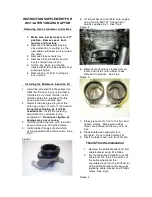
yellow
blue
1-27
When should an air bag inflate?
An air bag is designed to inflate in a moderate to severe
frontal or near
-
frontal crash. The air bag will inflate
only if the impact speed is above the system’s designed
“threshold level.” If your vehicle goes straight into a
wall that doesn’t move or deform, the threshold level is
about 9 to 16 mph (14 to 26 km/h). The threshold level
can vary, however, with specific vehicle design, so that
it can be somewhat above or below this range. If your
vehicle strikes something that will move or deform, such
as a parked car, the threshold level will be higher. The
air bag is not designed to inflate in rollovers, side
impacts or rear impacts, because inflation would not
help the occupant.
In any particular crash, no one can say whether an air
bag should have inflated simply because of the damage
to a vehicle or because of what the repair costs were.
Inflation is determined by the angle of the impact and
how quickly the vehicle slows down in frontal or
near
-
frontal impacts.
The air bag system is designed to work properly under a
wide range of conditions, including off
-
road usage.
Observe safe driving speeds, especially on rough terrain.
As always, wear your safety belt. See “Off
-
Road
Driving” in the Index for more tips on off
-
road driving.
What makes an air bag inflate?
In an impact of sufficient severity, the air bag sensing
system detects that the vehicle is in a crash. The sensing
system triggers a release of gas from the inflator, which
inflates the air bag. The inflator, air bag and related
hardware are all part of the air bag modules inside the
steering wheel and in the instrument panel in front of the
right front passenger.
How does an air bag restrain?
In moderate to severe frontal or near
-
frontal collisions,
even belted occupants can contact the steering wheel or
the instrument panel. Air bags supplement the protection
provided by safety belts. Air bags distribute the force of
the impact more evenly over the occupant’s upper body,
stopping the occupant more gradually. But air bags
would not help you in many types of collisions,
including rollovers, rear impacts and side impacts,
primarily because an occupant’s motion is not toward
those air bags. Air bags should never be regarded as
anything more than a supplement to safety belts,
and then only in moderate to severe frontal or
near
-
frontal collisions.
Summary of Contents for 1999 Yukon Denali
Page 6: ...yellowblue vi Model Reference This manual covers this model 4 Door Utility ...
Page 64: ...yellowblue 1 58 NOTES ...
Page 132: ...yellowblue 2 68 Instrument Panel ...
Page 225: ...yellowblue 4 55 NOTES ...
Page 226: ...yellowblue 4 56 NOTES ...
Page 261: ...yellowblue 5 35 NOTES ...
Page 262: ...yellowblue 5 36 NOTES ...
Page 328: ...yellowblue 6 66 NOTES ...
Page 372: ...yellowblue 7 44 Maintenance Record DATE ODOMETER READING SERVICED BY MAINTENANCE PERFORMED ...
Page 373: ...yellowblue 7 45 Maintenance Record DATE ODOMETER READING SERVICED BY MAINTENANCE PERFORMED ...
Page 374: ...yellowblue 7 46 Maintenance Record DATE ODOMETER READING SERVICED BY MAINTENANCE PERFORMED ...
Page 388: ...yellowblue 8 14 NOTES ...
















































